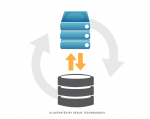WordPress could get very slow if used without limitations or protection. I wrote about Nginx HttpLimitReqModule and HttpLimitZoneModule a while ago which could be customised as following to protect WordPress blog.
http{
....
geo $limited {
default 1;
127.0.0.1 0;
}
map $limited $limit {
1 $binary_remote_addr;
0 "";
}
#http://wiki.nginx.org/HttpLimitConnModule
#concurrent connections limited to 200
limit_conn_zone $limit zone=concurrent:10m;
limit_conn_log_level warn;
limit_conn concurrent 200;
#http://wiki.nginx.org/HttpLimitReqModule
#PHP serve zone to limit requests to 50 per second
limit_req_zone $limit zone=php:10m rate=50r/s;
#limit searches to 100 request per minute
limit_req_zone $limit zone=search:10m rate=100r/m;
#login zone to limit login request to 1 request per second
limit_req_zone $limit zone=login:10m rate=1r/s;
limit_req_log_level warn;
server {
.....
error_page 449 = @search;
#limit search requests
if ( $arg_s ){
return 449;
}
location @search {
limit_req zone=search nodelay;
rewrite / /index.php?$args last;
include /etc/nginx/fastcgi_params;
}
location = /wp-login.php {
limit_req zone=login nodelay;
include /etc/nginx/fastcgi_params;
}
location ~ \.php$ {
limit_req zone=php burst=50;
include /etc/nginx/fastcgi_params;
}
If you are minifying scripts and css files using a caching plugin or using FastCGI cache then you might need to warmup your blog after purging your cache. This is a simple warm up cli script for WordPress to initiate cache or HHVM HHBC and making sure all pages/posts do not have errors. Additionally the script creates a urllist.txt file that you can use with siege to test load your server.
//in api/models/User.js
function validationError(invalidAttributes, status, message) {
var WLValidationError = require('../../node_modules/sails/node_modules/waterline/lib/waterline/error/WLValidationError.js');
return new WLValidationError({
invalidAttributes: invalidAttributes,
status: status,
message: message
}
);
}
var User = {
attributes: {
//...
},
ownValidate:: function (values, update, cb) {
//example of not allowed param on update
//if it is an update then do not allow email param
if (update && values.email) {
return cb(validationError({
email: [
{
message: 'Email is not allowed for updates.'
}
]
}, 400 /*status*/));
}
sails.models['user'].findOne(values.email).exec(function (err, user) {
if (err) return cb(err);
if (user) {
return cb(validationError({
email: [
{
value: values.email,
rule: 'E_UNIQUE'
/* unique validation message is left for the default one here */
}
]
}, 409));
}
});
},
beforeCreate: function (values, cb) {
return sails.models['user'].ownValidate(values, false, cb);
},
beforeUpdate: function (values, cb) {
return sails.models['user'].ownValidate(values, true, cb);
}
}
For blueprint custom messages validation
Sitemap Creator is a PHP class which creates XML sitemaps files compatible with the standard sitemaps.org protocol supported by Google and Bing.
Features
- Uses PHPCrawl class to crawl/spider the website and creates URLs set while all PHPCrawl methods and options are accessible through class.
- Ability to calculate Priority, Frequency and Last-Modified date with variety of options.
- Creates sitemaps in gzip format or uncompressed XML.
- Pings search engines with sitemaps locations.
- Reads from CSV files and exports entries in CSV format.
The script creates separate directory for every database and bz2 files for every table inside that database.
#!/bin/sh
#edit these
USER=""
PASSWORD=""
MYSQLDIR="/path/to/backupdir"
MYSQLDUMP="/usr/bin/mysqldump"
MYSQL="/usr/bin/mysql"
echo - Dumping DB structure "$MYSQLDIR"/all.bz2
$MYSQLDUMP --user=$USER --password=$PASSWORD -d --all-databases | bzip2 > "$MYSQLDIR"/all.bz2
echo - Dumping tables for each DB
databases=`$MYSQL --user=$USER --password=$PASSWORD -e "SHOW DATABASES;" | grep -Ev "(Database|information_schema)"`
for db in $databases; do
echo - Creating "$db" DB
mkdir $MYSQLDIR/$db
chmod -R 777 $MYSQLDIR/$db
for tb in `$MYSQL --user=$USER --password=$PASSWORD -N -B -e "use $db ;show tables"`
do
echo -- Creating table $tb
$MYSQLDUMP --opt --delayed-insert --insert-ignore --user=$USER --password=$PASSWORD $db $tb | bzip2 -c > $MYSQLDIR/$db/$tb.sql.bz2
done
echo
done










